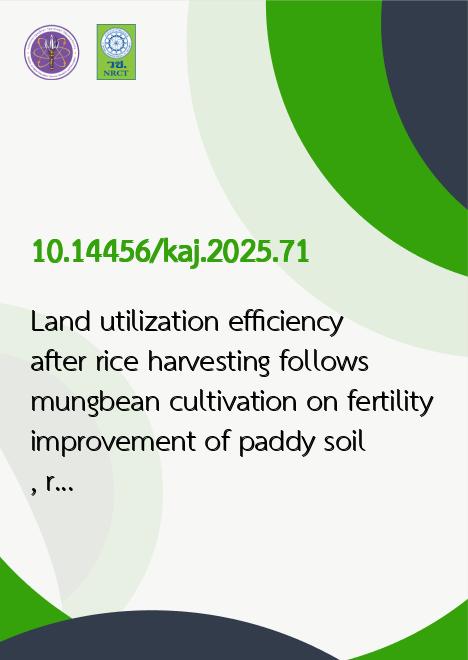
|
Land utilization efficiency after rice harvesting follows mungbean cultivation on fertility improvement of paddy soil, rice yield and economic benefit return under organic production: Case study Sikhoraphum District Surin Province |
|---|---|
| รหัสดีโอไอ | |
| Creator | Ajcharawadee Kruapukdee |
| Title | Land utilization efficiency after rice harvesting follows mungbean cultivation on fertility improvement of paddy soil, rice yield and economic benefit return under organic production: Case study Sikhoraphum District Surin Province |
| Contributor | Puchong Suphakwarangkun, Samnao Saowakoon, Nion Ngamhui, Udomsak Noppibool |
| Publisher | Faculty of Agriculture |
| Publication Year | 2568 |
| Journal Title | Khon Kaen Agriculture Journal |
| Journal Vol. | 53 |
| Journal No. | 5 |
| Page no. | 1019-1031 |
| Keyword | land utilization efficiency, paddy soil fertility, organic rice production, post-rice legume cultivation |
| URL Website | https://li01.tci-thaijo.org/index.php/agkasetkaj |
| Website title | Khon Kaen Agriculture Journal |
| ISSN | 3027-6497 (Online) |
| Abstract | Farmers in Surin Province face challenges such as soil infertility, declining crop yields, and rising production costs. The objective of this study was to examine the effects of post-rice mungbean cultivation under an organic farming system on soil fertility, rice yield, economic returns, and land use efficiency during the 2023-2024 growing season. Data was collected through interviews. The results showed that many farmers were female (65.45%), with males making up 34.55%. The average age of the farmers was 57 years, with 54.55% of respondents being in this age group. The majority (81.82%) completed primary education, and 81.82% had more than 10 years of experience in organic farming. The findings on land use efficiency indicated that post-rice legume cultivation significantly increased soil organic carbon (SOC = 2.50%) (P<0.05). Additionally, it enhanced soil chemical properties, including total nitrogen, available phosphorus, and exchangeable potassium. The yield of Khao Dawk Mali 105 rice under organic management ranged from 339.33 to 397.11 kg/rai. The yield from Khao Dawk Mali 105 followed by post-rice legume cultivation (397.11 kg/rai) was higher than that of Khao Dawk Mali 105 monoculture (339.33 kg/rai). The Land Equivalent Ratio (LER) for organic rice followed by post-rice legume cultivation was 2.68, indicating efficient land use. Post-rice legume cultivation not only improved soil fertility but also reduced production costs (1,916 THB/rai) and increased profits (2,758 THB/rai) compared to organic rice monoculture (production costs of 2,145 THB/rai and profits of 1,327 THB/rai). |